June 8th, 2009

Blogs, Twitter and wikis are ways of communicating or providing information.
A blog is a Web page where short articles or ‘posts’ can be added so that the most recent addition appears first on the page. Many blog publishing systems allow other people to comment on the article, and some systems exist for automatically finding other blog posts that mention the current post (‘trackbacks’). In this way, ‘full hypertext’ linking is possible and debates can be carried on over several Web sites.
A wiki is a collection of Web pages that can be edited by anyone or a selected group of people. When you edit a page, you can use a special format (often CamelCase) to create the name of a new page. When you save the change to the Wiki page that you edited, you can then edit the new page and add new content. If there is a large community organised around a wiki, then as people develop new ideas and break long pages down into shorter pages, coining new page names, they will produce and define a pattern language about the topic of the Wiki. In many wiki systems, the title of a page acts as a link to a search query that will list all the pages that point to that page.
Twitter is a specific Web site and mobile phone based communication system that allows members to publish short (140 characters) messages or ‘twits’. In the US, you can receive twits from people you follow on your phone or you can visit the Twitter page for that person. You can also send ‘twits’ yourself and these appear on your Twitter page. In the UK, you can send an sms message to a special mobile number and your twit will appear on your twitter page, and your followers will see your twit on their Web page profile. However, publication to phones is only available to Vodaphone customers as yet.
Google Wave is likely to provide new and interesting ways of communicating.
Posted in ILT, Notes | Tags: elearning, platforms | Comments Off
June 6th, 2009

FunnelBrain looked fun when I saw it on Jane’s E-learning Pick of the Day.
Alas, the site only works with MSIE 7+ and Firefox 3+. That cuts out Apple users, which is getting on for 20% of the 19-25 market in the US, and about one in 10 here. It also means we can’t use the site in the drop in IT centres at my college (XP/MSIE6), and we can’t use it in any of the Art/Media/Design areas (Apple).
If you want to design a collaborative site for use by students and teachers, you need to understand that teachers will not select technologies that exclude the one or two students in their class who do not have modern computers, or who can only access the Internet in public access facilities (which tend to have older operating systems and Web browsers).
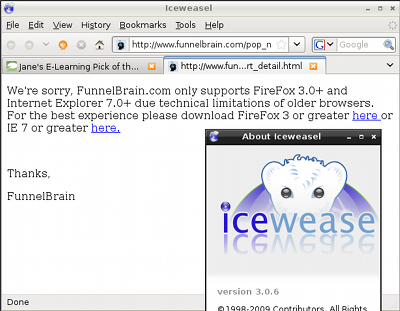
You also need to understand popular Linux distributions if you want any users in Africa or large parts of South America. I’m on Debian with Iceweasel and the site can’t even work out that Iceweasel is Firefox!
Posted in Notes | Tags: web | Comments Off
May 31st, 2009

Ruth’s been clearing out and found an old 10 Mark note. I could not resist scanning the detail with the Normal distribution on the front face next to the portrait of Gauss.
Posted in Maths | Tags: maths illustrations | Comments Off
May 27th, 2009

Download a PDF file containing a four page worksheet with graph plotting questions. There are two questions about plotting quadratics in the first quadrant, and these questions include plotting a straight line and reading off the intersection points. Another question is about finding the gradient and intercept of two straight line graphs and then writing down their formulas. A further question asks the student to plot two straight lines from supplied formulas, making up their own points.
Just a quick job using a spreadsheet to generate the grids and graphs (actually, I simply drew the straight line graphs onto the grid generated by a speadsheet).
Posted in 20 minutes, Maths | Tags: access, handouts, level 2, Maths | Comments Off
May 23rd, 2009
A readership survey aimed at people who read a collection of blogs and Websites that feature advertising from The Deck contains a trigonometry question. Things are looking up!
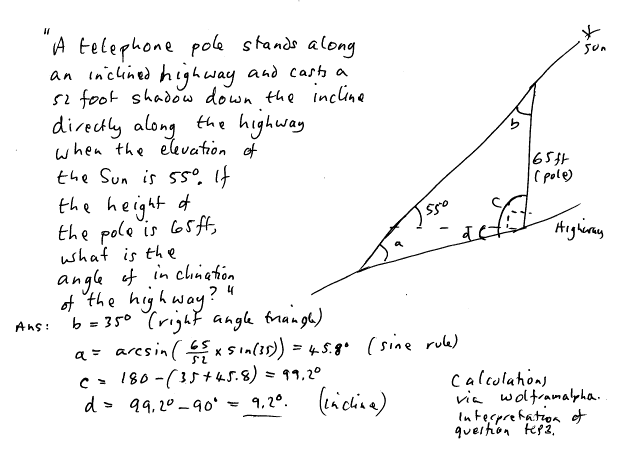
My solution is above, including the question. When I was spending spring afternoons in the pavilion doing maths homework, I hit on the idea of only using the sine ratio, Pythagoras’ result and the sine rule to solve these problems as it reduced the amount of things I needed to remember. I’ve used sine rule in the large triangle and then found the inclination of the road. This was a nostalgic exercise, and, as a result of not being able to find my Godfrey and Siddons or a scientific calculator to hand, I found myself using Wolfram Alpha to look up the trig ratios.
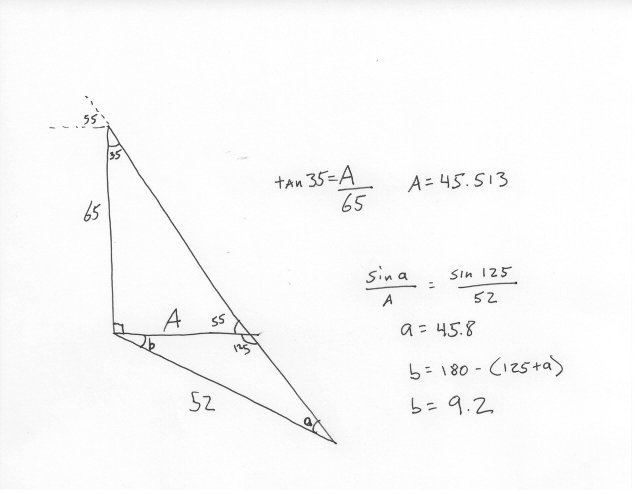
Steve Nicholson’s solution from daringfireball.net. This solution has gone for ‘projecting’ the pole shadow onto the horizontal and then solved the small triangle using sine rule.
Posted in Maths | Tags: Maths, trigonometry, web | Comments Off
May 22nd, 2009
Wolfram Alpha is a search engine for Maths. You can type things like “y = (x+1)(x-1)x” or “weather Birmingham UK 2008” and get graphs and data. You can type a search term like “x^3 – 2x = 10” and the system will solve the equation exactly or approximately and draw graphs of the curve showing the zero crossings. Alpha went ‘live’ last week.
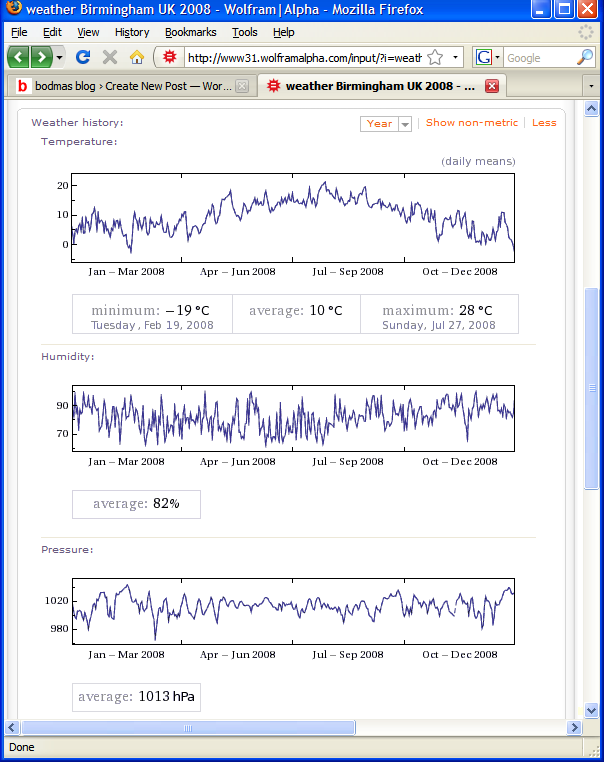
I’ve used Wolfram Alpha on the projector all this week with various Maths classes, mostly level 2. We are covering topics like ‘trial and improvement’ solution of equations and plotting quadratic graphs. The general response has been positive, and students have been quick to recognise that ‘you still have to understand the steps’, that just getting the answer has limited value in itself.
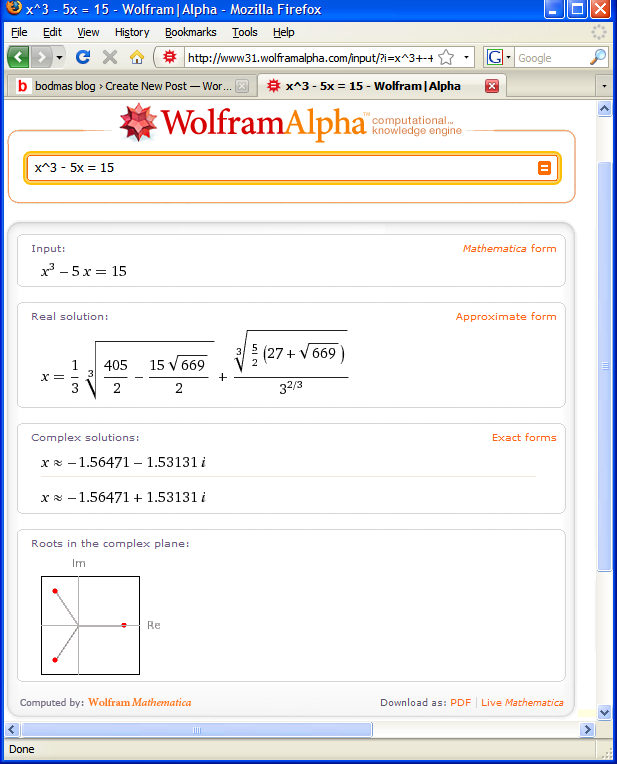
‘Searching’ on terms like “4.5Kg + 500g” produces answers in terms of both the units used. Terms like “y = 3x + 1” produce graphs, but you can’t alter the x or y range, and Alpha picks intervals that contains important features like zero crossings.
One group of three mature students who have GCSE and want to study AS Maths next year used Wolfram Alpha for half an hour in an IT session (it was my differentiation activity as most of the class were looking at BBC Bitesize pages or on s-cool for interactive equation solving activities). They solved an equation, admired the exact solution, and this lead onto research for the cubic formula. The statistics search lead to speculation about the impact of systems like Wolfram Alpha that can cross reference large quantities of information from a variety of sources. I’ll be revising my Mathematica commands to work out how to take the mean temperature figures for a number of UK cities over a period of time (smoothed means?) and to plot them geographically to show the gradient from North to South. A graphing task lead to the accidental discovery that Mathematica regards capital Y used in an expression as meaning the Bessel function, and it takes a guess at the order. Graphs need to be specified using lower case y and x variables!
I’ll work out more ways of using this system in the classroom. Searching on “prime factors of 68128” gives a list of the prime factors, so there could be activities early next academic year.
Posted in ILT, Maths | Tags: interactive, Learning, Maths, web | Comments Off
May 15th, 2009
I’ve changed over to the Bodmas minimal theme, based on ‘Zero’ while I test out an HTC TyTN phone on loan from the College. I’m trying to push the idea of a mobile phone as an e-learning material acquisition platform. More soon.
Posted in Notes | Tags: mobile, web | Comments Off








